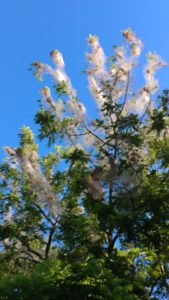Over the last few weeks, I have received a high number of calls about webs that are taking over trees in Williamson County. I can certainly understand the concern because they are ugly webs and they seem to spread from limb to limb.
The webs are created by fall webworm (Hyphantria cunea), a common caterpillar pest of trees. Fall webworm larvae are about an inch long, pale green or yellow, and covered in white and black hairs. They can cover entire branches with their webs, and the larvae feed within the webs on the tender parts of leaves. A heavy infestation of fall webworm will rarely kill a tree, but an infestation over several years can make a tree more susceptible to drought, disease, or insect pests.
Fall webworms live during winter as pupae on the ground or in sheltered spots around homes or in tree bark. The moths are 1 to 1 ½ inches with white wings, and they emerge in the spring to mate. Female moths can lay up to 600 eggs in a mass on the underside of leaves. The larvae hatch and immediately begin to build a web and eat the leaves inside the web, expanding the web as they consume the foliage. The larvae molt six or seven times before they leave the web to pupate. The life cycle from egg to adult is approximately 50 days. Fall webworms have two to four generations, depending on where they are in the state.
We have several options to control fall webworm, but it’s not always easy because the webs might be out of reach in the trees. If you can reach them, you can remove the webs, caterpillars, or egg masses by knocking them out of the tree with a stick or broom or pruning out the webs. Beneficial insects can help keep the population under control. You can help the beneficial insects by opening the web.
If the webs are too high to reach, try a hose-end or high-pressure sprayer. We have a few options for insecticides to help if you have a large infestation. The sprays must reach inside the web to be most effective because the webworm larvae stay inside the web. Insecticides containing Bt (Bacillus thuringiensis) or Spinosad are effective against fall webworm, and they will not harm beneficial insects. Carbaryl and pyrethroid insecticides are highly effective against fall webworm, but they should only be used for severe infestations because they are toxic to beneficial insects. Be sure to read the pesticide label carefully and spray carefully to avoid drift to other properties.
If you have any questions about controlling fall webworm, contact Kate Whitney, Williamson County Extension Horticulturalist, at 512-943-3300.


